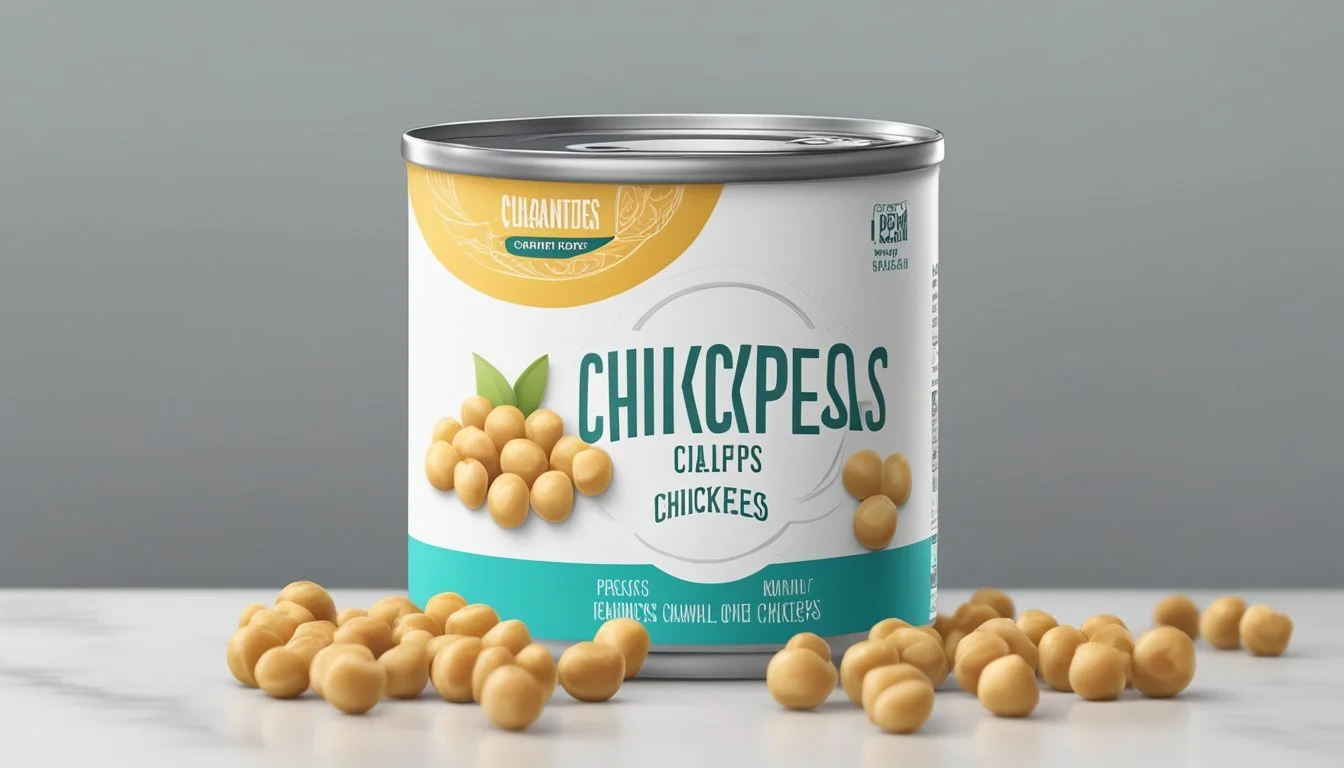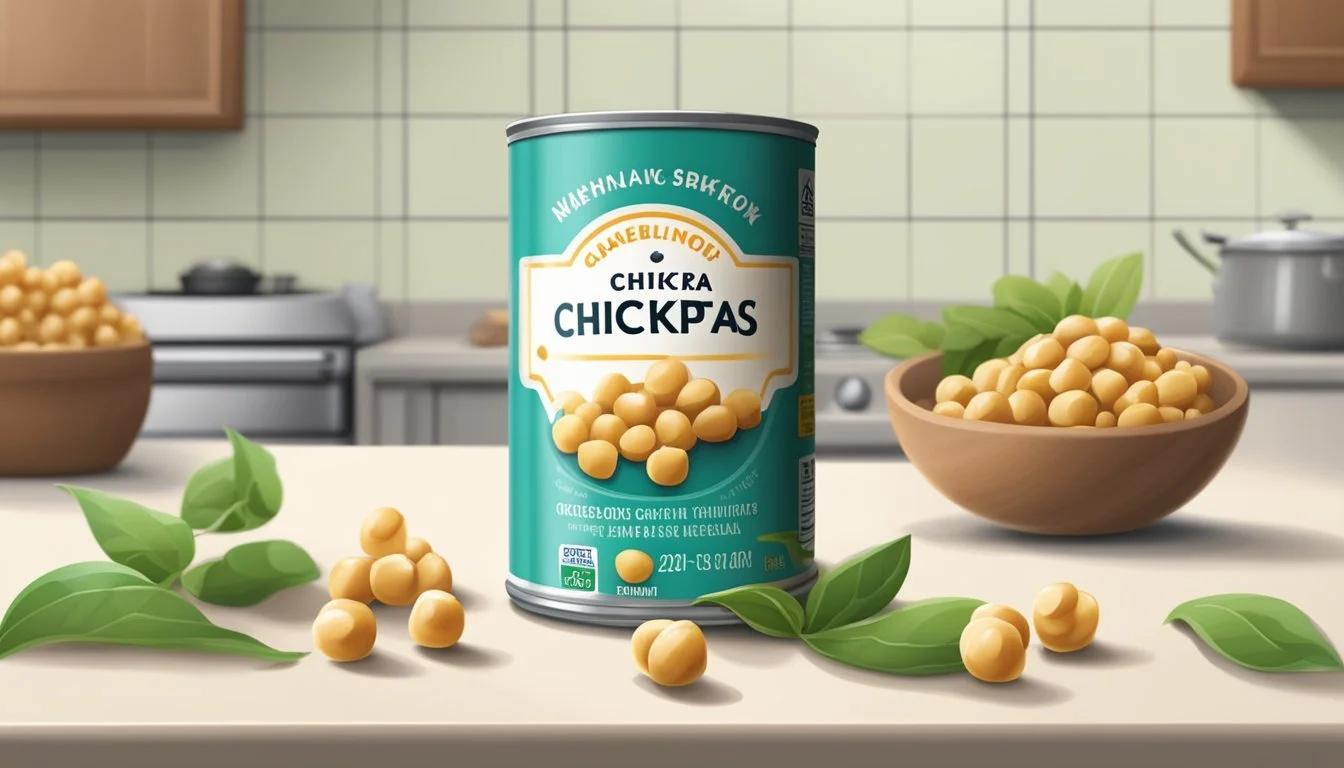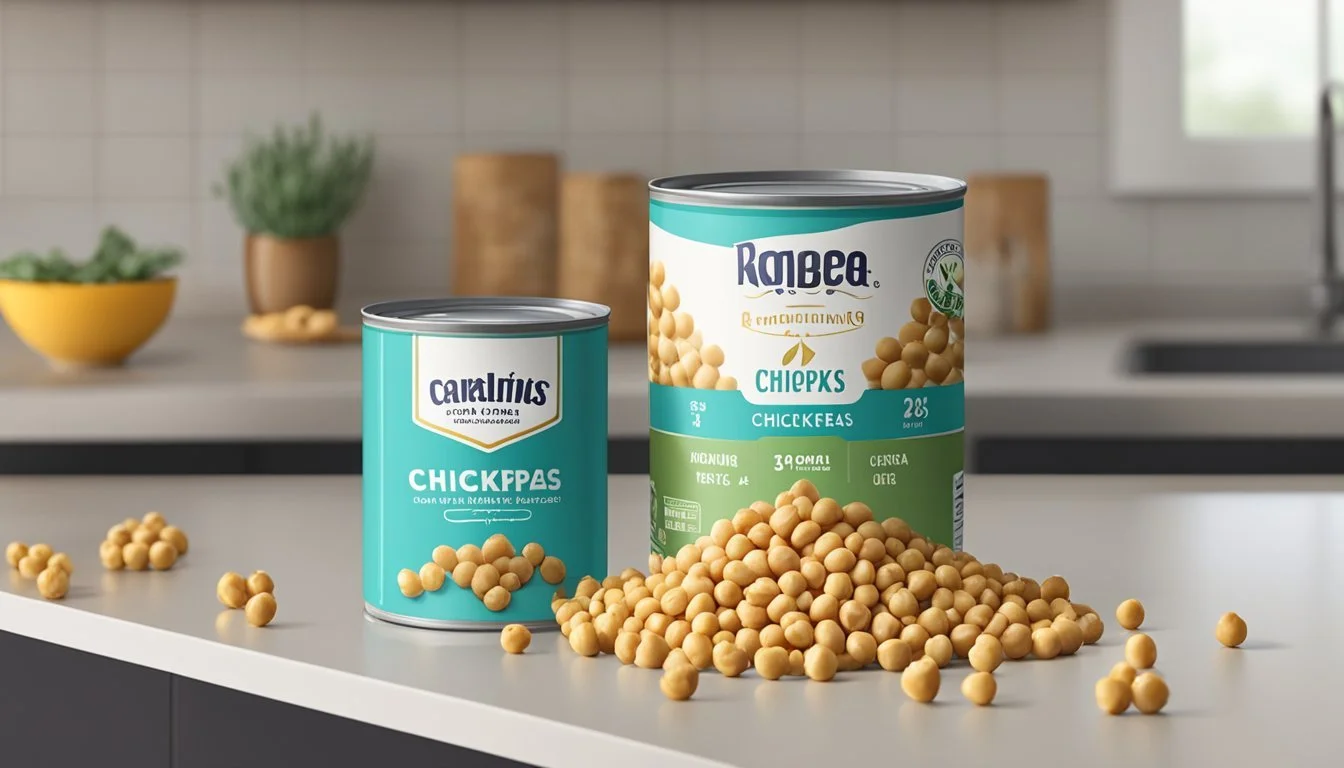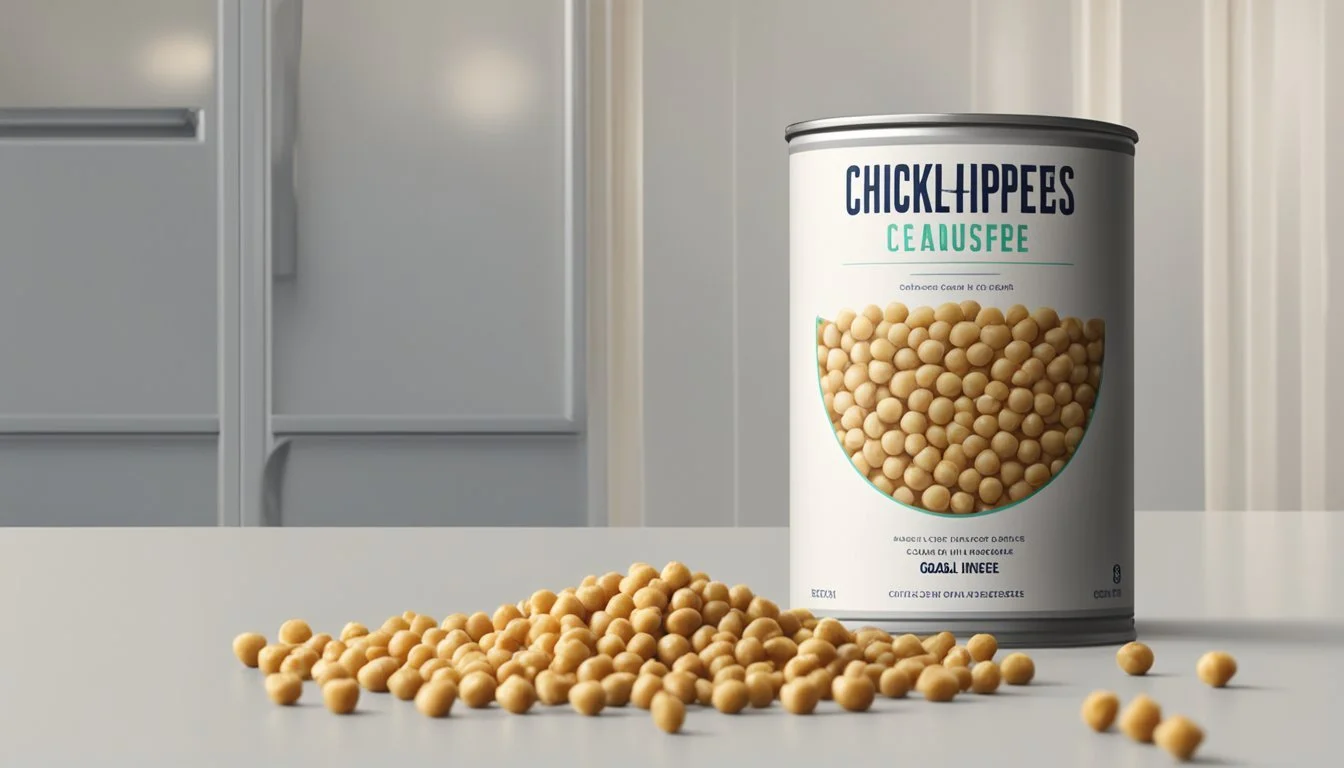How Many Ounces in a Can of Chickpeas
Understanding Can Sizes and Measurements
When purchasing canned chickpeas, consumers may notice a variety of can sizes on the shelves. The standard size, however, tends to be a 15-ounce can. This size typically holds approximately 1 1/2 to 2 cups of cooked chickpeas. The precise quantity can depend on several factors including the brand and the exact size of the chickpeas.
Immaterial differences in canning procedures and chickpea dimensions mean that the number of chickpeas in each can could vary slightly. Despite these variables, there exists a consensus in the culinary world that a 15-ounce can provides a reliable quantity of chickpeas, sufficient for individual recipes or as an ingredient in larger dishes. In weight terms, a drained and rinsed 15-ounce can of chickpeas roughly translates to 286 grams.
It is important for one to note that sizes other than the 15-ounce standard are available. For these other sizes, the amount of chickpeas within can increase or decrease proportionally. A larger 19-ounce can, for example, might contain up to 2 1/2 cups of chickpeas. Knowledge of these measurements is crucial for precise recipe planning and nutritional calculations.
Chickpeas Overview
Chickpeas, also known as garbanzo beans, are a versatile legume well-regarded for their rich nutrient profile and wide usage in various culinary applications, ranging from Mediterranean salads to South Asian stews. They come in different varieties and can be used either dried or canned.
Varieties of Chickpeas
There are two primary varieties of chickpeas: the Desi and the Kabuli. Desi chickpeas are smaller, darker, and have a rough coat. They are commonly used in Indian and Middle Eastern recipes. Kabuli chickpeas, often just referred to as garbanzo beans, are larger, lighter in color, and have a smoother coat.
Nutritional Profile
The nutritional content of chickpeas is noteworthy for its abundant protein, fiber, vitamins, and minerals. A single cup of chickpeas can provide a substantial amount of an adult's daily recommended intake of nutrients such as iron, folate, and other essential vitamins.
Key Nutrients in 1 Cup of Cooked Chickpeas:
Protein: Approximately 15 grams
Fiber: Around 13 grams
Iron: About 4.7 milligrams
Folate: Close to 282 micrograms
Common Uses in Cooking
Chickpeas are incredibly versatile in cooking. They are the foundation of hummus, a popular Middle Eastern dip. Chickpeas can be tossed into salads for a protein boost, simmered in soups and stews for a hearty element, or roasted and seasoned for a healthy snack. Additionally, they are an essential ingredient in many vegetarian and vegan recipes due to their substantial nutritional value and meat-like texture.
Canned Chickpeas
Canned chickpeas are a staple in many pantries due to their convenience and nutritional value. They typically come in 15-ounce cans and serve as a versatile ingredient in a variety of dishes.
Sodium Content and Health Considerations
The sodium content in canned chickpeas can vary significantly between brands. Consumers should read the label carefully to understand how much sodium is contained within. On average, a can might have anywhere from 200 to 400 milligrams of sodium per half-cup serving. For those monitoring their sodium intake, opting for low-sodium or no-salt-added options is advisable. Despite the sodium content, chickpeas are a nutritious choice, offering protein, fiber, and essential vitamins.
Ease of Use and Convenience
Canned chickpeas offer unmatched convenience. They are pre-cooked and ready to eat or add to recipes, saving time and effort. These legumes are versatile and can be used in salads, stews, dips, and more. Unlike dried chickpeas, there is no need for pre-soaking or lengthy cooking times.
Shelf Life and Storage
Chickpeas in cans have a long shelf life, often lasting for several years when unopened. Proper storage involves keeping the cans in a cool, dry place to avoid spoilage. Once opened, the chickpeas should be stored in a refrigerated container and consumed within a few days. Most brands add preservatives to extend the shelf life; however, the label will indicate the best before date for quality assurance.
Cooking with Chickpeas
When cooking with chickpeas, it's important to properly prepare them and understand the various cooking techniques which can affect their texture and flavor. Knowing the correct measurements and timings can greatly enhance the taste of these versatile legumes.
Preparing Dried Chickpeas
To start using dried chickpeas, they must first be soaked. This process is important as it helps reduce cooking time and improves their digestibility. Chickpeas should be placed in a large bowl and covered with water by at least 3 to 4 inches, allowing room for expansion. There are two main soaking methods:
Overnight Soaking: Leave the chickpeas to soak in the water for 24 hours.
Quick Soaking: Boil chickpeas for 2 minutes, then let them rest, covered, for 1 hour.
After soaking, chickpeas need to be drained and rinsed before cooking.
Cooking Times and Techniques
Cooking chickpeas properly is crucial for achieving the desired texture. Whether tender for hummus or firmer for salads, the cooking time will vary. Chickpeas can be cooked in a saucepan or in a pressure cooker like an Instant Pot. Here are the standard methods:
Stovetop: Place chickpeas in a saucepan with fresh water to cover them. Bring to a boil, then reduce heat to a simmer. Skim off any foam.
Pressure Cooking: Add soaked chickpeas to the pressure cooker with enough water to cover, and cook on high according to the machine's instructions (15-18 minutes for very tender chickpeas).
In both methods, if the aim is to enhance the flavor, ingredients like onion, garlic, oil, herbs, salt, and pepper can be added to the cooking water. Salt is best added towards the end of cooking to prevent toughening the chickpeas.
Culinary Inspirations
Chickpeas are incredibly versatile and can be incorporated into numerous recipes. Their ability to absorb flavors makes them ideal for a variety of cuisines. Here are ways to use chickpeas:
Browned in a Skillet: For a quick dish, sauté cooked chickpeas with spices until they begin to brown, imparting a nutty flavor and crunchy texture.
Blended: Pureed chickpeas can be turned into creamy hummus or used as a thickening agent in soups.
Baked: Chickpeas can be roasted in the oven until crispy, often seasoned, and used as a snack or salad topping.
Remember, accurate measurements when cooking chickpeas influence the end result. A standard can of chickpeas is 15 ounces, which is roughly equivalent to 1 1/2 cups of cooked chickpeas, or 1/2 cup of dry chickpeas pre-cooking.
Conversion and Measurements
When discussing the measurements and conversion data related to canned chickpeas, it's important to consider specifics. A standard can is 15 ounces and translates to varying volumes depending on whether the chickpeas are dry or cooked.
Cups to Ounces
One key conversion to note is from cups to ounces when dealing with cooked chickpeas. A standard 15-ounce can typically holds about 1 1/2 to 2 cups of cooked chickpeas. This lends a clear reference point for recipes that might list ingredients by volume rather than by weight.
Cups (cooked chickpeas) Ounces (can) 1 cup 10 ounces 1 1/2 cups 15 ounces 2 cups 20 ounces
Grams to Cups
For metric system users and those dealing with dry chickpeas, understanding the grams to cups conversion is essential. Approximately 200 grams of dried chickpeas equates to about 1 cup. Once cooked, this amount nearly triples in volume due to water absorption. See the conversion below for dried chickpeas:
Grams (dry chickpeas) Cups (dry) Cups (cooked) 100 grams 1/2 cup 1 1/2 cups 200 grams 1 cup 3 cups 300 grams 1 1/2 cups 4 1/2 cups
It's also worth mentioning that one shouldn't use the term 'servings' interchangeably with cups or ounces, as a 'serving' can vary based on dietary needs and recipe requirements.
Dietary Significance
Chickpeas are a nutrient-dense food rich in proteins and fiber, offering several health benefits that are crucial for various dietary needs including weight management, heart health, and specific dietary restrictions such as gluten-free and vegan diets.
Weight Management
Chickpeas can play a significant role in weight management because they are high in both protein and fiber. A single serve of chickpeas can provide up to 11 grams of protein and significant amounts of soluble fiber, which contribute to satiety, helping one feel full for longer periods and potentially reducing overall calorie intake.
Heart Healthy Benefits
Regular consumption of chickpeas can benefit cardiovascular health. The soluble fiber found in chickpeas helps to lower total and LDL cholesterol levels which are linked to reduced risk of heart disease. Moreover, their nutrient profile supports the maintenance of a balanced diet that is critical for overall heart health upkeep.
Gluten-Free and Vegan Diets
Chickpeas are inherently gluten-free and serve as an excellent protein source for those on gluten-free or vegan diets. This makes them an ideal dietary staple for individuals who avoid animal products or cannot consume gluten due to celiac disease or gluten sensitivity. Including chickpeas in one's diet can help ensure a varied intake of essential nutrients in these specialized diets.
Global Influence
The inclusion of chickpeas in various cuisines around the world is a testament to their versatility and cultural significance. They serve as a crucial ingredient in traditional dishes across the globe, particularly in Middle Eastern and Indian cuisine.
Chickpeas in Middle Eastern Cuisine
In Middle Eastern cuisine, chickpeas are a staple ingredient. They are essential to hummus, a creamy spread made of mashed chickpeas mixed with tahini, olive oil, lemon juice, and garlic. Additionally, chickpeas are often found in falafel, deep-fried balls or patties crafted from ground chickpeas and herbs. These dishes underscore the importance of chickpeas as a protein-rich food in a region where meat might not be as readily available.
Chickpeas in Indian Dishes
In India, chickpeas are equally pivotal and are referred to as "chana" in Hindi. They feature prominently in a variety of curries and snack dishes. Chana masala, a staple dish in Indian cuisine, consists of chickpeas cooked in a spicy tomato-based sauce with a blend of fragrant spices. Chickpeas are also often cooked into a thick stew known as dal, which is typically enjoyed with rice or bread. Indian cuisine celebrates chickpeas both for their flavor and their nutritional benefits.
Frequently Asked Questions
This section addresses common inquiries about the contents and various uses of canned chickpeas, including the differences between cooked and dry chickpeas as well as the benefits of both homemade and canned options.
Cooked vs. Dried Chickpeas
When purchasing chickpeas, consumers often wonder about the difference in volume between cooked and dried chickpeas. A 15 oz can typically contains about 1 1/2 to 2 cups of cooked chickpeas. In contrast, to yield the same amount of cooked beans, one would need approximately 1/2 cup of dry chickpeas. Additionally, one pound of dry chickpeas will expand to about 6 cups once cooked.
Aquafaba: A Unique Byproduct
An interesting byproduct of canned chickpeas is aquafaba, the liquid brine in which the chickpeas are stored. This brine can be used as a vegan substitute for egg whites in many recipes. The typical 15 oz can of chickpeas contains roughly 3/4 cup to 1 cup of this versatile liquid, offering additional culinary uses beyond the beans themselves.
Canned vs. Home-Cooked
Consumers often weigh the convenience of canned chickpeas against the perceived quality of home-cooked beans. Canned chickpeas offer immediate usability and a consistent product, while home-cooked chickpeas allow for control over the cooking process and seasoning. Nutritional differences are generally minimal, so the choice may come down to personal preference or specific culinary requirements.









